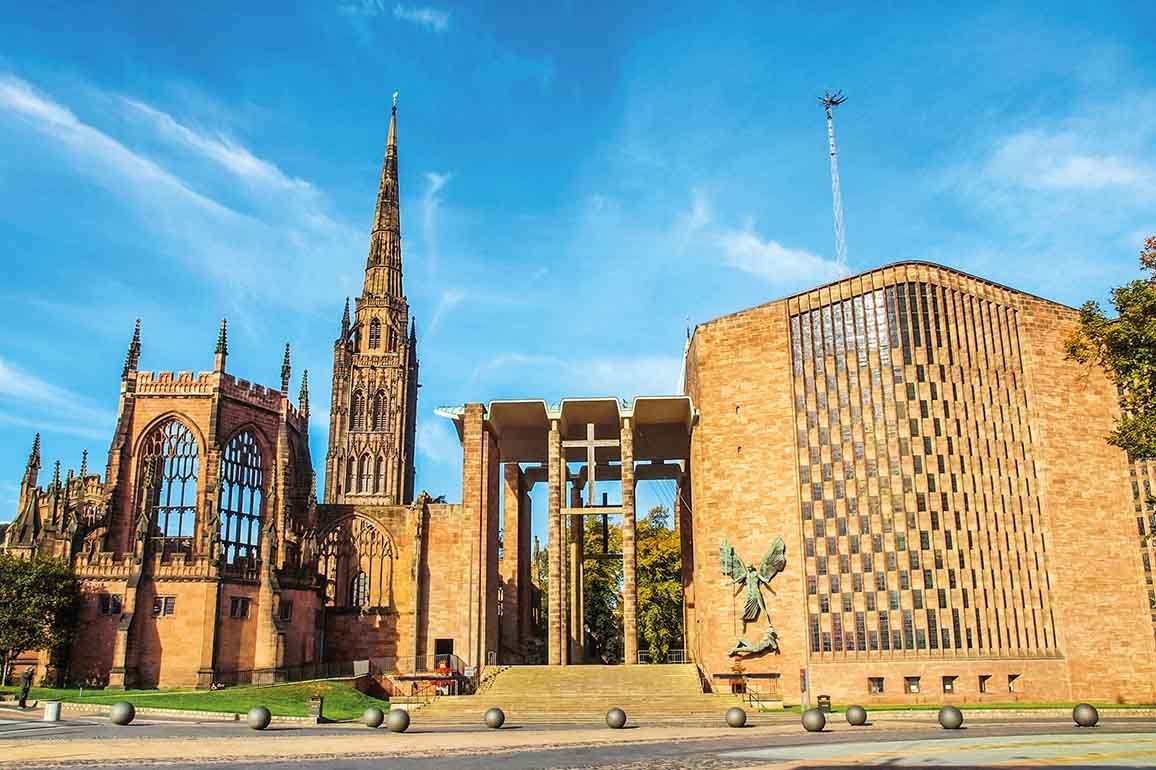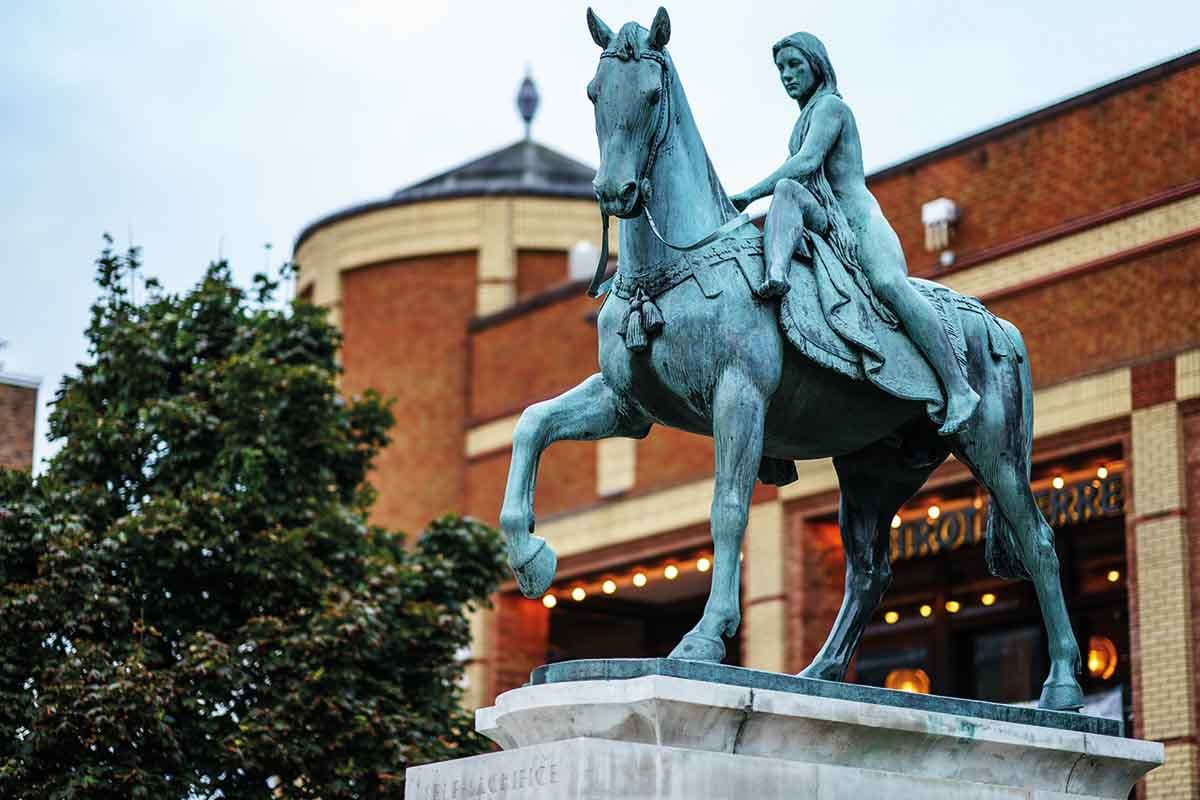
Rory Walsh is sent to Coventry, the UK City of Culture 2021
Discovering Britain
Trail • Urban • West Midlands • 0.5 miles • Web Guide
Coventry Moves. This is the strapline for Coventry’s year-long tenure as UK City of Culture 2021. The official website claims ‘This is the city where movement began’, a reference to Coventry’s heritage of making two-tone cars and 2-Tone ska records. The organisers set out that ‘we will celebrate our city with events, music, dance, theatre, and large-scale spectacle.’ Doing this during a global pandemic sounds like a challenge but Coventry has overcome adversity before. Coventry Moves could be the city’s motto and mantra, a phrase that sums up its often dramatic development.
‘Cities are never static. They must evolve to survive,’ says Martin Haslett, this trail’s creator. Coventry survived by evolving beyond recognition. After enduring the most infamous German bombing raid of the Second World War, Coventry’s ruins were swept away to create a radical city of the future. ‘In some ways it’s a well-known tale,’ says Haslett ‘but there is much more behind it.’ Haslett is a retired town planner from nearby Leamington Spa and explores not just how Coventry was transformed but why.
The route begins with a surprise. The view along Bayley Lane from the Golden Cross, a picturesque Tudor pub, almost recalls a Cotswolds village. In popular imagination, Coventry is a city of concrete rather than cobbles. Yet Bayley Lane offers a fascinating glimpse into Coventry’s past. On the right stand the weathered walls of St Mary’s Guildhall, built in 1340. The young William Shakespeare apparently trod its boards as an actor.

The UK City of Culture 2021 can trace its origins to a monastery founded nearby in 1043. By the 14th century Coventry was the fourth-largest settlement in England. Its early fortunes came from making wool and cloth. Over the next 600 years, Coventry moved on to ribbon, gloves, clocks, watches, sewing machines and bicycles. ‘Coventry has always been forward-looking rather than sentimental,’ says Haslett. But progress came with a price. By the 1930s roads like Bayley Lane were proving problematic.
‘Think about how a city works,’ says Haslett. ‘You need to bring together large groups of people to make things. As Coventry industrialised, they crowded in.’ The great accelerator was cars. The first UK car factory, a former cotton mill, was founded in Coventry in 1896. Before the decline of the British motor industry in the 1970s, Coventry was the UK’s nearest equivalent to Detroit. Daimler, Jaguar, Rover, Triumph, Hillman, Humber, Alvis, Singer, Riley… all hail from this Motown of the Midlands.
Between the two World Wars, demand for cars and workers to make them saw Coventry’s population double. The city itself remained roughly the same size, leading to cramped slums and congested streets. Coventry’s authorities drew up plans to relieve the pressure. Work had already started by the outbreak of the Second World War. When German bombing raids began over Britain, crowded Coventry’s array of factories presented a prime target. A famous reminder stands a few paces opposite the Guildhall. Coventry Cathedral.

From 14 November 1940, Coventry was bombed for 33 hours. Waves of incendiaries created a firestorm that ravaged the city, including the Cathedral. An estimated 583 people were killed and 1,000 injured. Thousands more were left homeless as more than 4,300 houses were destroyed. After the war, the Cathedral ruins were kept as a memorial. There has been debate ever since whether they, and the city, could have been restored to their former appearance.
‘In Europe, bombed cities like Warsaw and Dresden were painstakingly rebuilt. In Coventry, a conscious decision was made to do things differently,’ says Haslett. Embodying this approach was the new cathedral, built adjoining the old one as a symbol of progress and reconciliation. Sir Basil Spence’s startling design, with zig-zag walls and slit windows, still divides opinion. When the new cathedral opened in 1962, ‘It got a pretty bad press’ Haslett recalls. ‘It didn’t look like a cathedral and the things inside, like Graham Sutherland’s tapestry of Christ, were quite shocking.’
Beyond the building itself, its surroundings also feel very different. The open plaza outside is a sudden contrast with the narrow gorge of Bayley Lane. Coventry was rebuilt under chief architect Donald Gibson. A cornerstone of his Gibson Plan was to increase space and reduce traffic. The rest of the trail follows pedestrianised zones. There’s not a road to cross and hardly a car in sight until the end of the route at Coventry Market, with its unusual rooftop car park. Ironically but perhaps understandably, Britain’s car-making city was one of the first to explore being car-less.
This evolution is encapsulated by the Broadgate. Old photographs show it was once a cramped high street. Under the Gibson Plan, the transformed Broadgate became much broader. Roads and new shops surrounded a public square with a large lawn. A statue of Lady Godiva on horseback provided the centrepiece. She still surveys the square today but the lawn has gone. So have the roads around it. Within the last decade, the Broadgate has been pedestrianised completely.
Another of Coventry’s 1950s landmarks has also changed. The Precinct’s car-free streets, with shops on two levels, are rather like a post-war version of The Rows in Chester. ‘They were very innovative,’ says Haslett ‘but withgate shopping and leisure facilities you always need something new, some novelty to draw people in.’ Shopping outdoors in the British climate gradually fell out of favour. The Precinct gained elevators, a new floor, and sections of glass roof ‘but you still got wet if it rained’.
In the 1980s a new indoor shopping centre, Cathedral Lanes, was built beside the Broadgate. Though more modern it was less attractive. ‘The Gibson Plan had an “axial” design, with long views to different focal points,’ Haslett explains. ‘From the Precinct you could look back at the spire of the old Cathedral (the third-tallest in England), with Lady Godiva lined up below. Until the shopping centre was built.’

Haslett is pragmatic about how Coventry continues to evolve. ‘It reflects changing tastes and competing needs.’ As car-making and other local industries declined, expanding shopping and retail became more important than preserving a pleasant view. In the next few years, post-Covid, such financial forces will shape cities worldwide, especially those reliant upon retail. There is perhaps a parallel with the post-war years, another era of uncertainty looking ahead with optimism.
Haslett points out that rebuilt Coventry was the product of another age: ‘A lot of Britain’s post-war development was poor, poorly designed and poorly made. But after the war the country was broke. Things had to be done quickly and cheaply. Looking back now, we have time and comfort. We shouldn’t judge the objects of the past with the context of today.’ For Haslett, Coventry is often unfairly maligned. He suggests, ‘Rather than patching something up, the bravery of starting afresh is still striking.’
At the time of writing, the City Council were negotiating to buy the leasehold of the former Ikea building behind Coventry Market. The aim is to turn it into an international arts venue, a creative hub home to the Arts Council collection. ‘What a coup that would be,’ says Haslett. UK City of Culture 2021 begins on 15 May. ‘Visit in a few years’ time and we may see a totally different Coventry.’ From cloth mills, to car factories, to culture hubs, England’s most central city may be moving on again.

Go to the Discovering Britain website to find more hikes, short walks, or viewing points. Every landscape has a story to tell!




